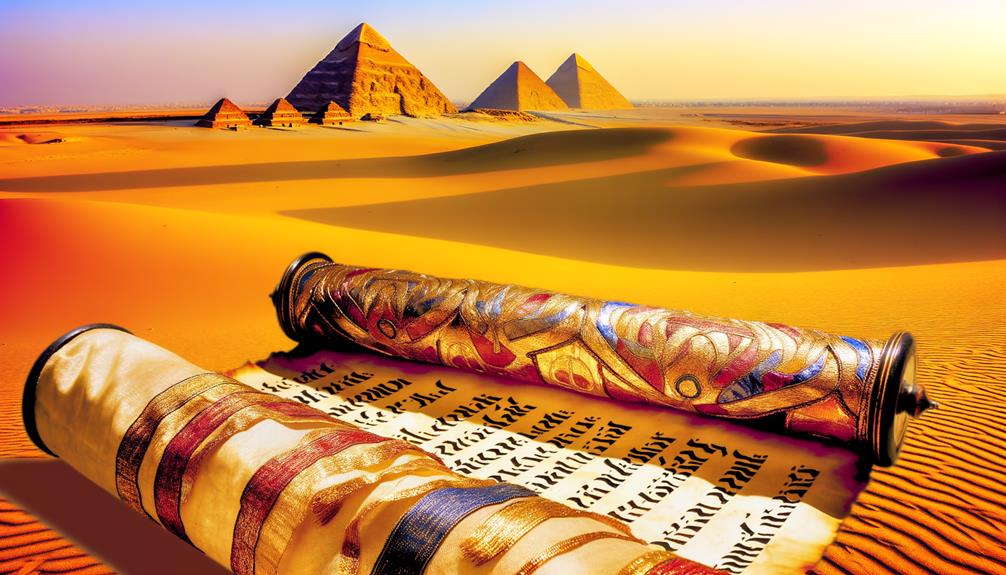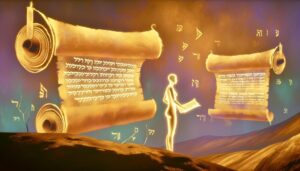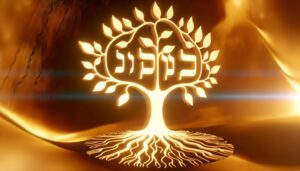Egypt Name Meaning in Hebrew
In Hebrew, Egypt is called 'Mitzrayim', a name full of rich meanings. It's not just a place but symbolizes bondage, divine deliverance, and even duality, reflecting ancient Egypt's geographical and political divisions.
The root 'tzar' implies narrowness and constraint, resonating with Israelite experiences of enslavement and oppression. Biblical narratives often depict Egypt as both a refuge and a land of exile, highlighting its complex role in salvation stories like the Exodus.
By exploring 'Mitzrayim', you'll uncover the intricate layers of symbolism that deeply influenced ancient Hebrew texts and cultural beliefs.

Key Takeaways
- 'Mitzrayim' in Hebrew symbolizes Egypt as a place of bondage and exile for the Israelites.
- The term 'Mitzrayim' is the dual form of 'Matzor,' reflecting Upper and Lower Egypt.
- 'Mitzrayim' derives from the root 'tzar,' suggesting narrowness or constraint.
- In biblical texts, Egypt represents both refuge and oppression for key figures like Abraham and Joseph.
- Egypt's dual nature as sanctuary and place of enslavement underscores its complex symbolism in Hebrew narratives.
The Hebrew Term 'Mitzrayim'
In Hebrew, Egypt is referred to as 'Mitzrayim', a term that appears frequently in biblical texts. When you encounter 'Mitzrayim' in scripture, it often signifies more than just a geographical location. It embodies a place of bondage and exile, deeply woven into the narrative of the Israelites' struggles and eventual liberation.
This term doesn't simply denote a country; it carries historical and emotional weight, symbolizing oppression and divine deliverance. By understanding 'Mitzrayim', you gain insight into the broader themes of confinement and redemption that permeate Hebrew texts. This duality enriches your comprehension of ancient scriptures, highlighting the complex relationship between the Israelites and their surroundings.
Etymology of Mitzrayim
The etymology of ‘Mitzrayim’ reveals a complex origin that provides deeper insight into its historical and cultural significance in Hebrew texts. ‘Mitzrayim’ is the dual form of the Hebrew word ‘Matzor,’ meaning ‘fortress’ or ‘enclosure,’ which hints at the duality of Upper and Lower Egypt. This duality is reflective not only of the geographical division of the region but also of the cultural and historical layers that have shaped Egyptian identity over millennia. Furthermore, the significance of ‘Mitzrayim’ extends into various biblical contexts, where it often symbolizes both physical and spiritual constriction, inviting deeper reflection on themes of exile and redemption. In examining names linked to this rich history, such as ‘Haggai,’ one can explore the ‘haggai name definition hebrew origins,’ which further enrich the tapestry of meanings found within Hebrew texts.
This name underscores the geographical and political divisions that characterized ancient Egypt. Additionally, the root 'tzar' suggests narrowness or constraint, reflecting the Nile's pivotal role in shaping the civilization's boundaries.
Understanding 'Mitzrayim' through its etymological roots allows you to appreciate how the Hebrews perceived Egypt's physical and sociopolitical landscape. Such analysis enriches your comprehension of ancient texts and their portrayal of Egypt.
Biblical References to Egypt
Within the Hebrew Bible, Egypt frequently appears as a land of both refuge and oppression, shaping its multifaceted role in the narrative.
You'll find that Egypt serves as a sanctuary for figures like Abraham and Joseph during times of famine, offering sustenance and safety.
Conversely, it's also depicted as a place of enslavement for the Israelites, highlighting the stark contrast in its portrayal.
The story of Moses and the Exodus underscores Egypt's dual nature, where it shifts from a place of refuge to one of severe oppression.
Understanding these biblical references deepens your grasp of Egypt's complex symbolism and its significance in shaping Hebrew identity and theological themes. Each reference is deliberate, emphasizing Egypt's pivotal role in biblical history.
Symbolism of Bondage and Narrowness
Egypt's depiction shifts from sanctuary to a symbol of bondage and narrowness, reflecting its role in the narrative of Israelite enslavement and the eventual quest for freedom. In Hebrew, the name 'Mitzrayim' evokes the notion of constraint and limitation. This etymology aligns with the Israelites' experiences, where Egypt became synonymous with oppression and a lack of autonomy.
The journey from Egypt to the Promised Land represents not only physical liberation but also spiritual and emotional release from confinement. By understanding Egypt as a place of restriction, you grasp the deeper implications of the Exodus story. This transformation from refuge to prison underscores the complexities of Egypt's symbolism in the Hebrew tradition, highlighting themes of suffering and redemption.
Cultural Interplay in Ancient Texts
Cultural interplay in ancient texts reveals how diverse civilizations influenced each other through shared narratives and symbolism. You can see this clearly in the interactions between ancient Egypt and Hebrew texts. Egyptian mythology and iconography often found their way into Hebrew stories, enriching the cultural tapestry and providing deeper layers of meaning.
For instance, the concept of Ma'at (order) in Egyptian texts parallels the Hebrew idea of divine justice. Additionally, the exchange of language and metaphors across these cultures demonstrates a fluid, integrated worldview. By studying these texts, you uncover a rich dialogue where ideas, beliefs, and symbols aren't static but dynamic, evolving through cross-cultural exchanges.
This interplay not only broadens your understanding but also highlights the interconnectedness of ancient societies.
Conclusion
You've now seen how the Hebrew term 'Mitzrayim' encapsulates Egypt's complex identity.
You've explored its origins, investigated its biblical references, and grasped its symbolism of bondage and narrowness.
These insights reveal not just historical facts, but also cultural interplay in ancient texts. By analyzing these elements, you've gained a richer understanding of how language shapes perception.
Remember, every term carries layers of meaning that bridge the past with the present.






